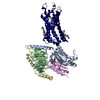+ データを開く
データを開く
- 基本情報
基本情報
| 登録情報 | 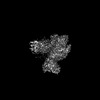 | |||||||||
|---|---|---|---|---|---|---|---|---|---|---|
| タイトル | Cryo-EM structure of the anamorelin-bound ghrelin receptor and Gq complex | |||||||||
 マップデータ マップデータ | ||||||||||
 試料 試料 |
| |||||||||
 キーワード キーワード | GPCR / SBDD / Cachexia / MEMBRANE PROTEIN | |||||||||
| 機能・相同性 |  機能・相同性情報 機能・相同性情報growth hormone secretagogue receptor activity / regulation of hindgut contraction / regulation of growth hormone secretion / positive regulation of small intestinal transit / negative regulation of locomotion involved in locomotory behavior / growth hormone-releasing hormone receptor activity / regulation of gastric motility / response to follicle-stimulating hormone / regulation of transmission of nerve impulse / ghrelin secretion ...growth hormone secretagogue receptor activity / regulation of hindgut contraction / regulation of growth hormone secretion / positive regulation of small intestinal transit / negative regulation of locomotion involved in locomotory behavior / growth hormone-releasing hormone receptor activity / regulation of gastric motility / response to follicle-stimulating hormone / regulation of transmission of nerve impulse / ghrelin secretion / positive regulation of appetite / growth hormone secretion / negative regulation of norepinephrine secretion / positive regulation of small intestine smooth muscle contraction / negative regulation of macrophage apoptotic process / positive regulation of eating behavior / adult feeding behavior / negative regulation of appetite / actin polymerization or depolymerization / positive regulation of multicellular organism growth / cellular response to thyroid hormone stimulus / response to growth hormone / regulation of postsynapse organization / positive regulation of insulin-like growth factor receptor signaling pathway / response to L-glutamate / positive regulation of vascular endothelial cell proliferation / negative regulation of interleukin-1 beta production / response to food / positive regulation of fatty acid metabolic process / cellular response to insulin-like growth factor stimulus / response to dexamethasone / regulation of synapse assembly / positive regulation of sprouting angiogenesis / regulation of neurotransmitter receptor localization to postsynaptic specialization membrane / decidualization / negative regulation of interleukin-6 production / peptide hormone binding / negative regulation of tumor necrosis factor production / postsynaptic modulation of chemical synaptic transmission / response to hormone / hormone-mediated signaling pathway / insulin-like growth factor receptor signaling pathway / Peptide ligand-binding receptors / synaptic membrane / negative regulation of insulin secretion / G protein-coupled receptor activity / negative regulation of inflammatory response / Schaffer collateral - CA1 synapse / Olfactory Signaling Pathway / Activation of the phototransduction cascade / G beta:gamma signalling through PLC beta / Presynaptic function of Kainate receptors / Thromboxane signalling through TP receptor / G protein-coupled acetylcholine receptor signaling pathway / G-protein activation / cellular response to insulin stimulus / Activation of G protein gated Potassium channels / Inhibition of voltage gated Ca2+ channels via Gbeta/gamma subunits / Prostacyclin signalling through prostacyclin receptor / G beta:gamma signalling through CDC42 / Glucagon signaling in metabolic regulation / G beta:gamma signalling through BTK / Synthesis, secretion, and inactivation of Glucagon-like Peptide-1 (GLP-1) / ADP signalling through P2Y purinoceptor 12 / photoreceptor disc membrane / Sensory perception of sweet, bitter, and umami (glutamate) taste / Glucagon-type ligand receptors / Adrenaline,noradrenaline inhibits insulin secretion / Vasopressin regulates renal water homeostasis via Aquaporins / Glucagon-like Peptide-1 (GLP1) regulates insulin secretion / G alpha (z) signalling events / cellular response to catecholamine stimulus / ADP signalling through P2Y purinoceptor 1 / ADORA2B mediated anti-inflammatory cytokines production / G beta:gamma signalling through PI3Kgamma / Cooperation of PDCL (PhLP1) and TRiC/CCT in G-protein beta folding / adenylate cyclase-activating dopamine receptor signaling pathway / GPER1 signaling / Inactivation, recovery and regulation of the phototransduction cascade / cellular response to prostaglandin E stimulus / response to estradiol / G-protein beta-subunit binding / heterotrimeric G-protein complex / G alpha (12/13) signalling events / sensory perception of taste / extracellular vesicle / signaling receptor complex adaptor activity / Thrombin signalling through proteinase activated receptors (PARs) / retina development in camera-type eye / cellular response to lipopolysaccharide / GTPase binding / Ca2+ pathway / fibroblast proliferation / High laminar flow shear stress activates signaling by PIEZO1 and PECAM1:CDH5:KDR in endothelial cells / spermatogenesis / G alpha (i) signalling events / G alpha (s) signalling events / phospholipase C-activating G protein-coupled receptor signaling pathway / G alpha (q) signalling events / Ras protein signal transduction 類似検索 - 分子機能 | |||||||||
| 生物種 |  Homo sapiens (ヒト) / Homo sapiens (ヒト) /   | |||||||||
| 手法 | 単粒子再構成法 / クライオ電子顕微鏡法 / 解像度: 2.9 Å | |||||||||
 データ登録者 データ登録者 | Im D / Shimura Y / Asada H / Iwata S | |||||||||
| 資金援助 |  日本, 1件 日本, 1件
| |||||||||
 引用 引用 |  ジャーナル: Nat Struct Mol Biol / 年: 2025 ジャーナル: Nat Struct Mol Biol / 年: 2025タイトル: The structure and function of the ghrelin receptor coding for drug actions. 著者: Yuki Shiimura / Dohyun Im / Ryosuke Tany / Hidetsugu Asada / Ryoji Kise / Eon Kurumiya / Hideko Wakasugi-Masuho / Satoshi Yasuda / Kazuma Matsui / Jun-Ichi Kishikawa / Takayuki Kato / Takeshi ...著者: Yuki Shiimura / Dohyun Im / Ryosuke Tany / Hidetsugu Asada / Ryoji Kise / Eon Kurumiya / Hideko Wakasugi-Masuho / Satoshi Yasuda / Kazuma Matsui / Jun-Ichi Kishikawa / Takayuki Kato / Takeshi Murata / Masayasu Kojima / So Iwata / Ikuo Masuho /   要旨: Drugs targeting the ghrelin receptor hold therapeutic potential in anorexia, obesity and diabetes. However, developing effective drugs is challenging. To tackle this common issue across a broad drug ...Drugs targeting the ghrelin receptor hold therapeutic potential in anorexia, obesity and diabetes. However, developing effective drugs is challenging. To tackle this common issue across a broad drug target, this study aims to understand how anamorelin, the only approved drug targeting the ghrelin receptor, operates compared to other synthetic drugs. Our research elucidated the receptor's structure with anamorelin and miniG, unveiling anamorelin's superagonistic activity. We demonstrated that ligands with distinct chemical structures uniquely bind to the receptor, resulting in diverse conformations and biasing signal transduction. Moreover, our study showcased the utility of structural information in effectively identifying natural genetic variations altering drug action and causing severe functional deficiencies, offering a basis for selecting the right medication on the basis of the individual's genomic sequence. Thus, by building on structural analysis, this study enhances the foundational framework for selecting therapeutic agents targeting the ghrelin receptor, by effectively leveraging signaling bias and genetic variations. | |||||||||
| 履歴 |
|
- 構造の表示
構造の表示
| 添付画像 |
|---|
- ダウンロードとリンク
ダウンロードとリンク
-EMDBアーカイブ
| マップデータ |  emd_36627.map.gz emd_36627.map.gz | 114.6 MB |  EMDBマップデータ形式 EMDBマップデータ形式 | |
|---|---|---|---|---|
| ヘッダ (付随情報) |  emd-36627-v30.xml emd-36627-v30.xml emd-36627.xml emd-36627.xml | 25.4 KB 25.4 KB | 表示 表示 |  EMDBヘッダ EMDBヘッダ |
| 画像 |  emd_36627.png emd_36627.png | 80.8 KB | ||
| Filedesc metadata |  emd-36627.cif.gz emd-36627.cif.gz | 7.4 KB | ||
| その他 |  emd_36627_additional_1.map.gz emd_36627_additional_1.map.gz emd_36627_half_map_1.map.gz emd_36627_half_map_1.map.gz emd_36627_half_map_2.map.gz emd_36627_half_map_2.map.gz | 114.6 MB 115.6 MB 115.6 MB | ||
| アーカイブディレクトリ |  http://ftp.pdbj.org/pub/emdb/structures/EMD-36627 http://ftp.pdbj.org/pub/emdb/structures/EMD-36627 ftp://ftp.pdbj.org/pub/emdb/structures/EMD-36627 ftp://ftp.pdbj.org/pub/emdb/structures/EMD-36627 | HTTPS FTP |
-検証レポート
| 文書・要旨 |  emd_36627_validation.pdf.gz emd_36627_validation.pdf.gz | 714.9 KB | 表示 |  EMDB検証レポート EMDB検証レポート |
|---|---|---|---|---|
| 文書・詳細版 |  emd_36627_full_validation.pdf.gz emd_36627_full_validation.pdf.gz | 714.5 KB | 表示 | |
| XML形式データ |  emd_36627_validation.xml.gz emd_36627_validation.xml.gz | 14.2 KB | 表示 | |
| CIF形式データ |  emd_36627_validation.cif.gz emd_36627_validation.cif.gz | 16.8 KB | 表示 | |
| アーカイブディレクトリ |  https://ftp.pdbj.org/pub/emdb/validation_reports/EMD-36627 https://ftp.pdbj.org/pub/emdb/validation_reports/EMD-36627 ftp://ftp.pdbj.org/pub/emdb/validation_reports/EMD-36627 ftp://ftp.pdbj.org/pub/emdb/validation_reports/EMD-36627 | HTTPS FTP |
-関連構造データ
| 関連構造データ | 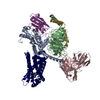 8jsrMC M: このマップから作成された原子モデル C: 同じ文献を引用 ( |
|---|---|
| 類似構造データ | 類似検索 - 機能・相同性  F&H 検索 F&H 検索 |
- リンク
リンク
| EMDBのページ |  EMDB (EBI/PDBe) / EMDB (EBI/PDBe) /  EMDataResource EMDataResource |
|---|---|
| 「今月の分子」の関連する項目 |
- マップ
マップ
| ファイル |  ダウンロード / ファイル: emd_36627.map.gz / 形式: CCP4 / 大きさ: 125 MB / タイプ: IMAGE STORED AS FLOATING POINT NUMBER (4 BYTES) ダウンロード / ファイル: emd_36627.map.gz / 形式: CCP4 / 大きさ: 125 MB / タイプ: IMAGE STORED AS FLOATING POINT NUMBER (4 BYTES) | ||||||||||||||||||||||||||||||||||||
|---|---|---|---|---|---|---|---|---|---|---|---|---|---|---|---|---|---|---|---|---|---|---|---|---|---|---|---|---|---|---|---|---|---|---|---|---|---|
| 投影像・断面図 | 画像のコントロール
画像は Spider により作成 | ||||||||||||||||||||||||||||||||||||
| ボクセルのサイズ | X=Y=Z: 0.88 Å | ||||||||||||||||||||||||||||||||||||
| 密度 |
| ||||||||||||||||||||||||||||||||||||
| 対称性 | 空間群: 1 | ||||||||||||||||||||||||||||||||||||
| 詳細 | EMDB XML:
|
-添付データ
-追加マップ: #1
| ファイル | emd_36627_additional_1.map | ||||||||||||
|---|---|---|---|---|---|---|---|---|---|---|---|---|---|
| 投影像・断面図 |
| ||||||||||||
| 密度ヒストグラム |
-ハーフマップ: #1
| ファイル | emd_36627_half_map_1.map | ||||||||||||
|---|---|---|---|---|---|---|---|---|---|---|---|---|---|
| 投影像・断面図 |
| ||||||||||||
| 密度ヒストグラム |
-ハーフマップ: #2
| ファイル | emd_36627_half_map_2.map | ||||||||||||
|---|---|---|---|---|---|---|---|---|---|---|---|---|---|
| 投影像・断面図 |
| ||||||||||||
| 密度ヒストグラム |
- 試料の構成要素
試料の構成要素
-全体 : Anamorelin-bound ghrelin receptor in complex with Gq
| 全体 | 名称: Anamorelin-bound ghrelin receptor in complex with Gq |
|---|---|
| 要素 |
|
-超分子 #1: Anamorelin-bound ghrelin receptor in complex with Gq
| 超分子 | 名称: Anamorelin-bound ghrelin receptor in complex with Gq タイプ: complex / ID: 1 / 親要素: 0 / 含まれる分子: #2-#6, #1 |
|---|---|
| 由来(天然) | 生物種:  Homo sapiens (ヒト) Homo sapiens (ヒト) |
| 分子量 | 理論値: 190 KDa |
-分子 #1: Growth hormone secretagogue receptor type 1
| 分子 | 名称: Growth hormone secretagogue receptor type 1 / タイプ: protein_or_peptide / ID: 1 / コピー数: 1 / 光学異性体: LEVO |
|---|---|
| 由来(天然) | 生物種:  Homo sapiens (ヒト) Homo sapiens (ヒト) |
| 分子量 | 理論値: 58.82702 KDa |
| 組換発現 | 生物種:  |
| 配列 | 文字列: WNATPSEEPG FNLTLADLDW DASPGNDSLG DELLQLFPAP LLAGVTATCV ALFVVGIAGN LLTMLVVSRF RELRTTTNLY LSSMAFSDL LIFLCMPLDL VRLWQYRPWN FGDLLCKLFQ FVSESCTYAT VLTITALSVE RYFAICFPLR AKVVVTKGRV K LVIFVIWA ...文字列: WNATPSEEPG FNLTLADLDW DASPGNDSLG DELLQLFPAP LLAGVTATCV ALFVVGIAGN LLTMLVVSRF RELRTTTNLY LSSMAFSDL LIFLCMPLDL VRLWQYRPWN FGDLLCKLFQ FVSESCTYAT VLTITALSVE RYFAICFPLR AKVVVTKGRV K LVIFVIWA VAFCSAGPIF VLVGVEHENG TDPWDTNECR PTEFAVRSGL LTVMVWVSSI FFFLPVFCLT VLYSLIGRKL WR RRRGDAV VGASLRDQNH KQTVKMLAVV VFAFILCWLP FHVGRYLFSK SFEPGSLEIA QISQYCNLVS FVLFYLSAAI NPI LYNIMS KKYRVAVFRL LGFEPFSQRK LSTLKDESSR AWTESSINTV FTLEDFVGDW EQTAAYNLDQ VLEQGGVSSL LQNL AVSVT PIQRIVRSGE NALKIDIHVI IPYEGLSADQ MAQIEEVFKV VYPVDDHHFK VILPYGTLVI DGVTPNMLNY FGRPY EGIA VFDGKKITVT GTLWNGNKII DERLITPDGS MLFRVTINS UniProtKB: Growth hormone secretagogue receptor type 1 |
-分子 #2: Engineered G-alpha-q
| 分子 | 名称: Engineered G-alpha-q / タイプ: protein_or_peptide / ID: 2 / コピー数: 1 / 光学異性体: LEVO |
|---|---|
| 由来(天然) | 生物種:  Homo sapiens (ヒト) Homo sapiens (ヒト) |
| 分子量 | 理論値: 41.724383 KDa |
| 組換発現 | 生物種:  |
| 配列 | 文字列: MGCTLSAEDK AAVERSKMIE KQLQKDKQVY RRTLRLLLLG ADNSGKSTIV KQMRIYHVNG YSEEECKQYK AVVYSNTIQS IIAIIRAMG RLKIDFGDSA RADDARQLFV LAGAAEEGFM TAELAGVIKR LWKDSGVQAC FNRSREYQLN DSAAYYLNDL D RIAQPNYI ...文字列: MGCTLSAEDK AAVERSKMIE KQLQKDKQVY RRTLRLLLLG ADNSGKSTIV KQMRIYHVNG YSEEECKQYK AVVYSNTIQS IIAIIRAMG RLKIDFGDSA RADDARQLFV LAGAAEEGFM TAELAGVIKR LWKDSGVQAC FNRSREYQLN DSAAYYLNDL D RIAQPNYI PTQQDVLRTR VKTSGIFETK FQVDKVNFHM FDVGAQRDER RKWIQCFNDV TAIIFVVDSS DYNRLQEALN DF KSIWNNR WLRTISVILF LNKQDLLAEK VLAGKSKIED YFPEFARYTT PEDATPEPGE DPRVTRAKYF IRKEFVDIST ASG DGRHIC YPHFTCSVDT ENARRIFNDC KDIILQMNLR EYNLV |
-分子 #3: Guanine nucleotide-binding protein G(I)/G(S)/G(T) subunit beta-1
| 分子 | 名称: Guanine nucleotide-binding protein G(I)/G(S)/G(T) subunit beta-1 タイプ: protein_or_peptide / ID: 3 / コピー数: 1 / 光学異性体: LEVO |
|---|---|
| 由来(天然) | 生物種:  Homo sapiens (ヒト) Homo sapiens (ヒト) |
| 分子量 | 理論値: 42.282156 KDa |
| 組換発現 | 生物種:  |
| 配列 | 文字列: MHHHHHHHHH HLEVLFQGPG SSGSELDQLR QEAEQLKNQI RDARKACADA TLSQITNNID PVGRIQMRTR RTLRGHLAKI YAMHWGTDS RLLVSASQDG KLIIWDSYTT NKVHAIPLRS SWVMTCAYAP SGNYVACGGL DNICSIYNLK TREGNVRVSR E LAGHTGYL ...文字列: MHHHHHHHHH HLEVLFQGPG SSGSELDQLR QEAEQLKNQI RDARKACADA TLSQITNNID PVGRIQMRTR RTLRGHLAKI YAMHWGTDS RLLVSASQDG KLIIWDSYTT NKVHAIPLRS SWVMTCAYAP SGNYVACGGL DNICSIYNLK TREGNVRVSR E LAGHTGYL SCCRFLDDNQ IVTSSGDTTC ALWDIETGQQ TTTFTGHTGD VMSLSLAPDT RLFVSGACDA SAKLWDVREG MC RQTFTGH ESDINAICFF PNGNAFATGS DDATCRLFDL RADQELMTYS HDNIICGITS VSFSKSGRLL LAGYDDFNCN VWD ALKADR AGVLAGHDNR VSCLGVTDDG MAVATGSWDS FLKIWNGSSG GGGSGGGGSS GVSGWRLFKK IS UniProtKB: Guanine nucleotide-binding protein G(I)/G(S)/G(T) subunit beta-1 |
-分子 #4: scFv16
| 分子 | 名称: scFv16 / タイプ: protein_or_peptide / ID: 4 / コピー数: 1 / 光学異性体: LEVO |
|---|---|
| 由来(天然) | 生物種:  |
| 分子量 | 理論値: 27.784896 KDa |
| 組換発現 | 生物種:  |
| 配列 | 文字列: DVQLVESGGG LVQPGGSRKL SCSASGFAFS SFGMHWVRQA PEKGLEWVAY ISSGSGTIYY ADTVKGRFTI SRDDPKNTLF LQMTSLRSE DTAMYYCVRS IYYYGSSPFD FWGQGTTLTV SSGGGGSGGG GSGGGGSDIV MTQATSSVPV TPGESVSISC R SSKSLLHS ...文字列: DVQLVESGGG LVQPGGSRKL SCSASGFAFS SFGMHWVRQA PEKGLEWVAY ISSGSGTIYY ADTVKGRFTI SRDDPKNTLF LQMTSLRSE DTAMYYCVRS IYYYGSSPFD FWGQGTTLTV SSGGGGSGGG GSGGGGSDIV MTQATSSVPV TPGESVSISC R SSKSLLHS NGNTYLYWFL QRPGQSPQLL IYRMSNLASG VPDRFSGSGS GTAFTLTISR LEAEDVGVYY CMQHLEYPLT FG AGTKLEL KAAAHHHHHH HH |
-分子 #5: Guanine nucleotide-binding protein G(I)/G(S)/G(O) subunit gamma-2
| 分子 | 名称: Guanine nucleotide-binding protein G(I)/G(S)/G(O) subunit gamma-2 タイプ: protein_or_peptide / ID: 5 / コピー数: 1 / 光学異性体: LEVO |
|---|---|
| 由来(天然) | 生物種:  Homo sapiens (ヒト) Homo sapiens (ヒト) |
| 分子量 | 理論値: 7.861143 KDa |
| 組換発現 | 生物種:  |
| 配列 | 文字列: MASNNTASIA QARKLVEQLK MEANIDRIKV SKAAADLMAY CEAHAKEDPL LTPVPASENP FREKKFFCAI L UniProtKB: Guanine nucleotide-binding protein G(I)/G(S)/G(O) subunit gamma-2 |
-分子 #6: Nb35
| 分子 | 名称: Nb35 / タイプ: protein_or_peptide / ID: 6 / コピー数: 1 / 光学異性体: LEVO |
|---|---|
| 由来(天然) | 生物種:  |
| 分子量 | 理論値: 14.016636 KDa |
| 組換発現 | 生物種:  |
| 配列 | 文字列: MQVQLQESGG GLVQPGGSLR LSCAASGFTF SNYKMNWVRQ APGKGLEWVS DISQSGASIS YTGSVKGRFT ISRDNAKNTL YLQMNSLKP EDTAVYYCAR CPAPFTRDCF DVTSTTYAYR GQGTQVTVSS |
-分子 #7: 2-azanyl-N-[(2R)-1-[(3R)-3-[dimethylamino(methyl)carbamoyl]-3-(ph...
| 分子 | 名称: 2-azanyl-N-[(2R)-1-[(3R)-3-[dimethylamino(methyl)carbamoyl]-3-(phenylmethyl)piperidin-1-yl]-3-(1H-indol-3-yl)-1-oxidanylidene-propan-2-yl]-2-methyl-propanamide タイプ: ligand / ID: 7 / コピー数: 1 / 式: UYI |
|---|---|
| 分子量 | 理論値: 546.704 Da |
-実験情報
-構造解析
| 手法 | クライオ電子顕微鏡法 |
|---|---|
 解析 解析 | 単粒子再構成法 |
| 試料の集合状態 | particle |
- 試料調製
試料調製
| 濃度 | 10 mg/mL |
|---|---|
| 緩衝液 | pH: 7.5 |
| グリッド | モデル: Quantifoil R1.2/1.3 / 材質: COPPER / メッシュ: 300 / 前処理 - タイプ: GLOW DISCHARGE / 前処理 - 気圧: 0.007 kPa |
| 凍結 | 凍結剤: ETHANE / チャンバー内湿度: 100 % / チャンバー内温度: 281.15 K / 装置: FEI VITROBOT MARK IV |
- 電子顕微鏡法
電子顕微鏡法
| 顕微鏡 | FEI TITAN KRIOS |
|---|---|
| 撮影 | フィルム・検出器のモデル: GATAN K3 BIOQUANTUM (6k x 4k) 平均電子線量: 60.0 e/Å2 |
| 電子線 | 加速電圧: 300 kV / 電子線源:  FIELD EMISSION GUN FIELD EMISSION GUN |
| 電子光学系 | 照射モード: FLOOD BEAM / 撮影モード: BRIGHT FIELD / 最大 デフォーカス(公称値): 1.8 µm / 最小 デフォーカス(公称値): 0.8 µm |
| 試料ステージ | 試料ホルダーモデル: FEI TITAN KRIOS AUTOGRID HOLDER |
| 実験機器 |  モデル: Titan Krios / 画像提供: FEI Company |
- 画像解析
画像解析
| 初期モデル | モデルのタイプ: PDB ENTRY PDBモデル - PDB ID: |
|---|---|
| 最終 再構成 | 解像度のタイプ: BY AUTHOR / 解像度: 2.9 Å / 解像度の算出法: FSC 0.143 CUT-OFF / 使用した粒子像数: 500563 |
| 初期 角度割当 | タイプ: MAXIMUM LIKELIHOOD |
| 最終 角度割当 | タイプ: MAXIMUM LIKELIHOOD |
 ムービー
ムービー コントローラー
コントローラー




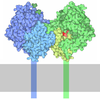


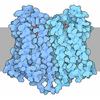
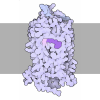



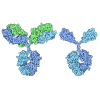








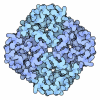
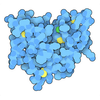



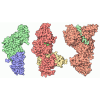
 X (Sec.)
X (Sec.) Y (Row.)
Y (Row.) Z (Col.)
Z (Col.)












































